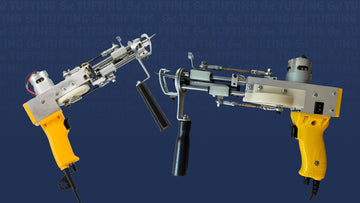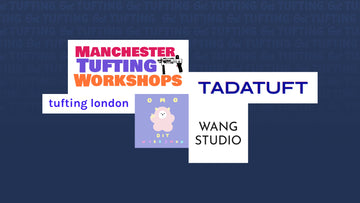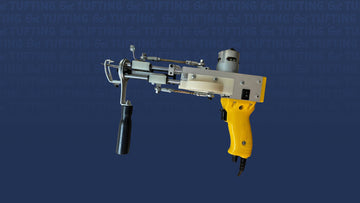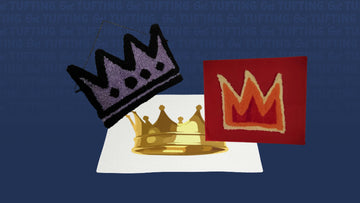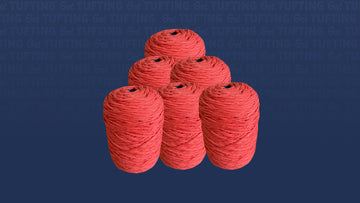If you have experience working with yarn or rugs, you may be familiar with tufting guns. However, if you're new to tufting, you may want to learn more about these tools before purchasing one.
Fortunately, here on gettufting.com, we offer a variety of tufting guns and supplies, and we've provided all the essential information you need to get started with tufting. Not only is tufting a beautiful activity, but it can also be a fun and profitable craft. By selling your handmade rugs, you can even earn some extra income.
Before purchasing a tufting gun, it's important to understand what tufting is, how tufting guns work, and what types of supplies are available. Once you have this information, you'll be able to make an informed purchase decision.
Table of Contents
- What are Tufting Guns?
- How do tufting machines work?
- What's the difference between Cut Pile and Loop Pile tufting guns?
- Where to Buy Tufting Guns
- Other Tufting Supplies
- How to Begin
What are tufting guns?
Tufting guns are handheld machines used in the creation of rugs. They work by punching yarn or other materials into a fabric backing to create a dense pile. Tufting guns are significantly faster than traditional rug-making techniques such as latch hooking or punch needling, and they allow for greater precision and control in the design process.
These devices are held in the palm of the hand and typically have cords that connect to an electrical source. They come in various types and sizes and are used by both hobbyists and professionals to create rugs of various sizes and complexities.
How do tufting machines work?
Tufting machines work by using a needle to punch strands of yarn or other materials into a fabric backing. The needle is operated by a motor or manually, and it penetrates the backing material at a very high speed, creating loops of yarn on one side of the backing and a dense pile on the other side.
The yarn or other materials are fed through a hollow needle, which is then pushed through the fabric backing by the machine. Once the needle penetrates the fabric, it releases the yarn, and a loop is formed on the other side. The needle is then retracted, and the process is repeated to create additional loops until the desired pattern is achieved.
Different tufting machines work differently depending on their design, but the general process of pushing yarn through a fabric backing to create a pile is the same. Some machines may be operated manually, while others are powered by electricity or compressed air. The density and height of the pile can be adjusted on most machines to create different textures and patterns in the final product.
What's the difference between Cut Pile and Loop Pile tufting guns?
The main difference between cut pile and loop pile tufting guns is the type of pile they create.
Cut pile tufting guns create a pile that has been cut on the surface, resulting in a soft and plush texture. The tufting gun cuts the yarn loops as they are pushed through the fabric backing, creating a pile that stands upright. Cut pile tufting guns are commonly used for creating carpets, area rugs, and upholstery.
On the other hand, loop pile tufting guns create a pile that consists of loops that are not cut on the surface. The yarn is simply pushed through the fabric backing and left as loops, resulting in a dense and durable texture. Loop pile tufting guns are commonly used for creating Berber carpets, commercial carpet tiles, and outdoor rugs.
Some tufting guns can switch between cut pile and loop pile by adjusting the blade mechanism, while others are designed specifically for one type of pile. The choice between cut pile and loop pile tufting guns ultimately depends on the desired texture and durability of the final product.
Where to Buy Tufting Guns
If you're new to tufting, you may not want to invest in the most expensive tufting gun available. Fortunately, there is a reliable supplier that offers beginner-friendly tufting guns that are also suitable for more advanced work as you improve your skills.Gettufting.com offers an easy and affordable cut & loop model in two variants:
- 2021 Tufting Gun: Perfect as a basic model. As seen in most Youtube and TikTok videos.
- 2023 Tufting Gun: New and improved! Better build quality, ergonomic design, and an adjustable pile heights wheel.
Other Tufting Supplies
Primary Tufting Cloth
At Gettufting, the primary tufting fabric is made from a blend of 35% cotton and 65% polyester. It has a density of 26 stitches per inch in both directions and weighs around 2 pounds per yard. This fabric has double weft and double warp threads and includes mark lines throughout, making it ideal for rug tufting hobbyists.
The fabric is available in a default width of 1 to 39 inches, and you can select the amount you need between 1 to 3 meters, with a maximum length of 10 meters. The price of the fabric will be discounted if you purchase a large quantity, which will be reflected in the final price.
Our tufting cloth is available in light and dark.
Secondary Backing Cloth
The finishing fabric is bonded to the carpet's back and protects it from the back or underside. Because of the additional layer, it is not only more durable, but also substantially softer. More information about the function and requirement of the finishing fabric, as well as the different varieties, can be found on our blog.
Finishing Twill Tape
Carpet Binding Tape or Twill Tape is ideal for finishing the carpet on the back. Because of the bias weave, the tape may be bent around curves. Avilable in light or dark.
Rug Yarns
Gettufting's rug yarns come in a huge assortment of hues. These rug fibers work best with tufting machines. Since they are made entirely of acrylic, they are ideal for creating rugs and other projects requiring yarn.
The Gettufting tufting guns are perfect for using the soft-yet-sturdy rug yarn, which is available in three sizes so you can get precisely what you need for your projects.
How to Begin
If you're interested in creating your own rug with a tufting gun, you're in luck! With the right tools and some basic knowledge, anyone can get started with tufting.
First, you'll need to gather your materials. You'll need a tufting gun, fabric backing, tufting cloth, and yarn in your desired color(s). You can purchase all of these items from a supplier like Gettufting.
Once you have your materials, you'll want to decide on the design and size of your rug. Sketch out your design on paper or use a digital design tool to create a visual plan.
Next, you'll need to transfer your design onto the fabric backing. You can use a water-soluble marker or chalk to draw your design onto the backing. Make sure your design is centered and symmetrical.
After you have your design transferred, it's time to load your tufting gun with yarn. Thread the yarn through the needle and into the gun, then adjust the depth and tension settings according to the thickness of your yarn and the desired pile height.
Now it's time to start tufting! Hold the tufting gun perpendicular to the fabric backing and push the needle through the backing, creating a loop on the other side. Continue tufting until you've filled in your entire design.
Once you've finished tufting, trim any excess yarn with scissors or a rotary cutter. Finally, secure the ends of your yarn with a strong adhesive like hot glue or fabric glue.
With a little practice and patience, you'll be creating beautiful tufted rugs in no time! Remember to take breaks and stretch your hands to avoid any strain or discomfort from the repetitive motion of tufting.
